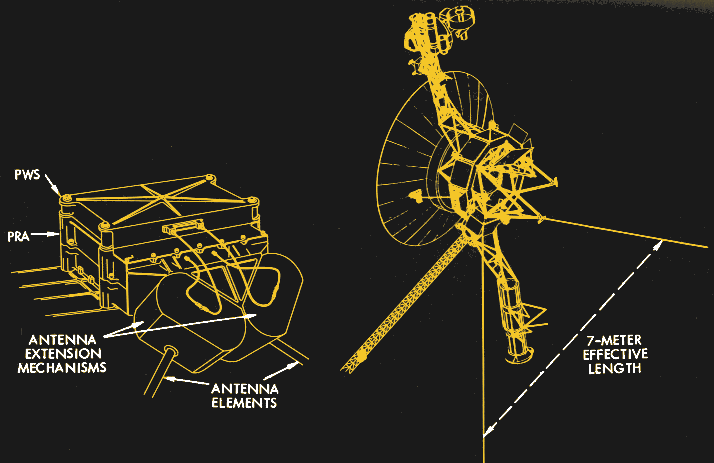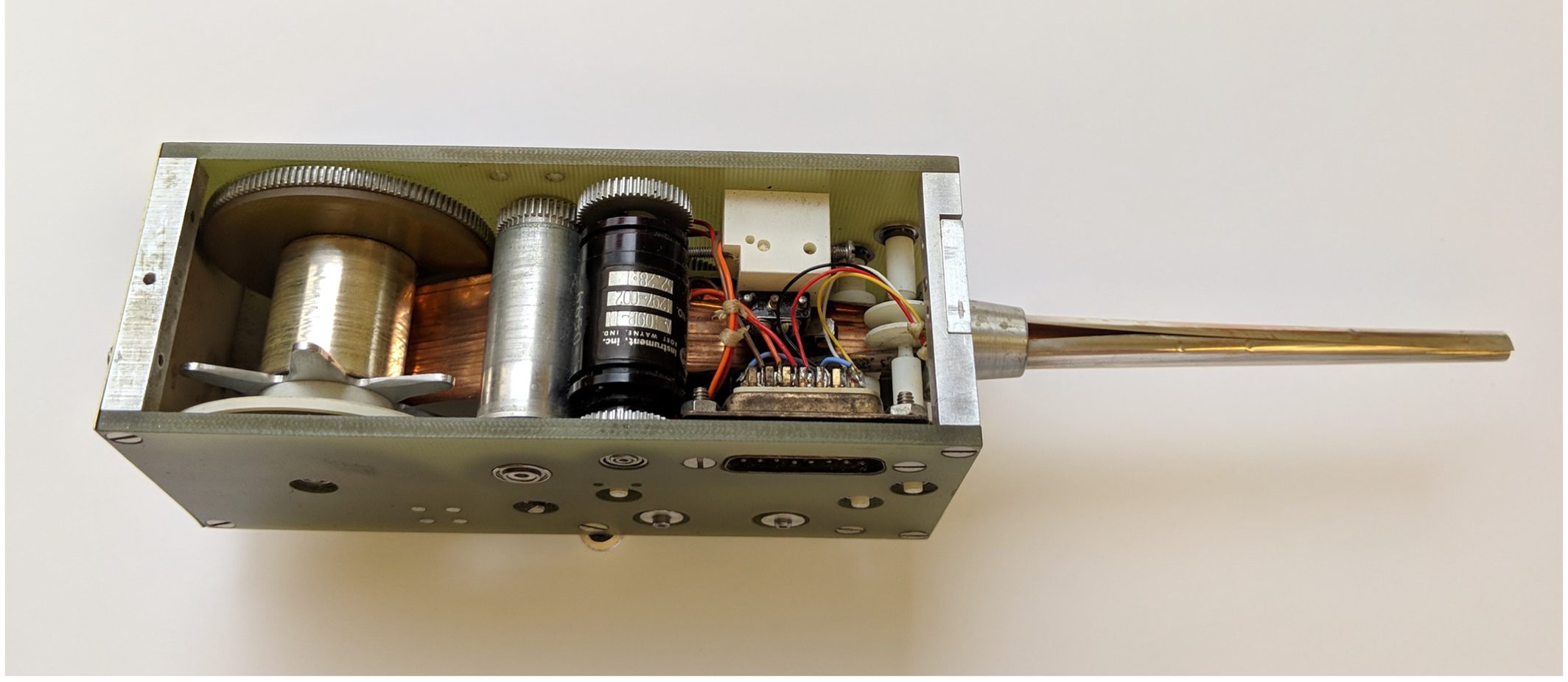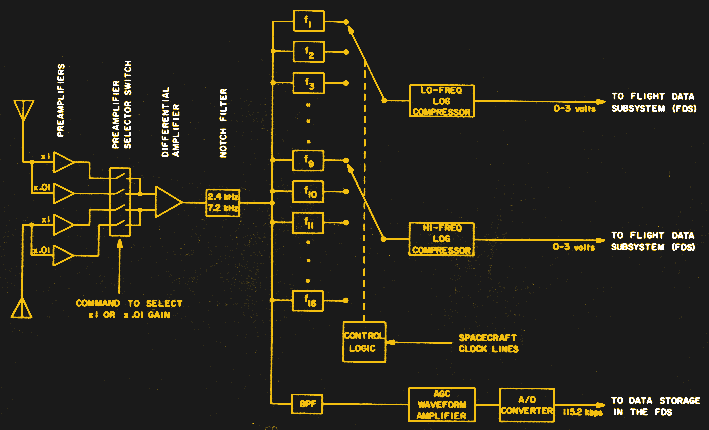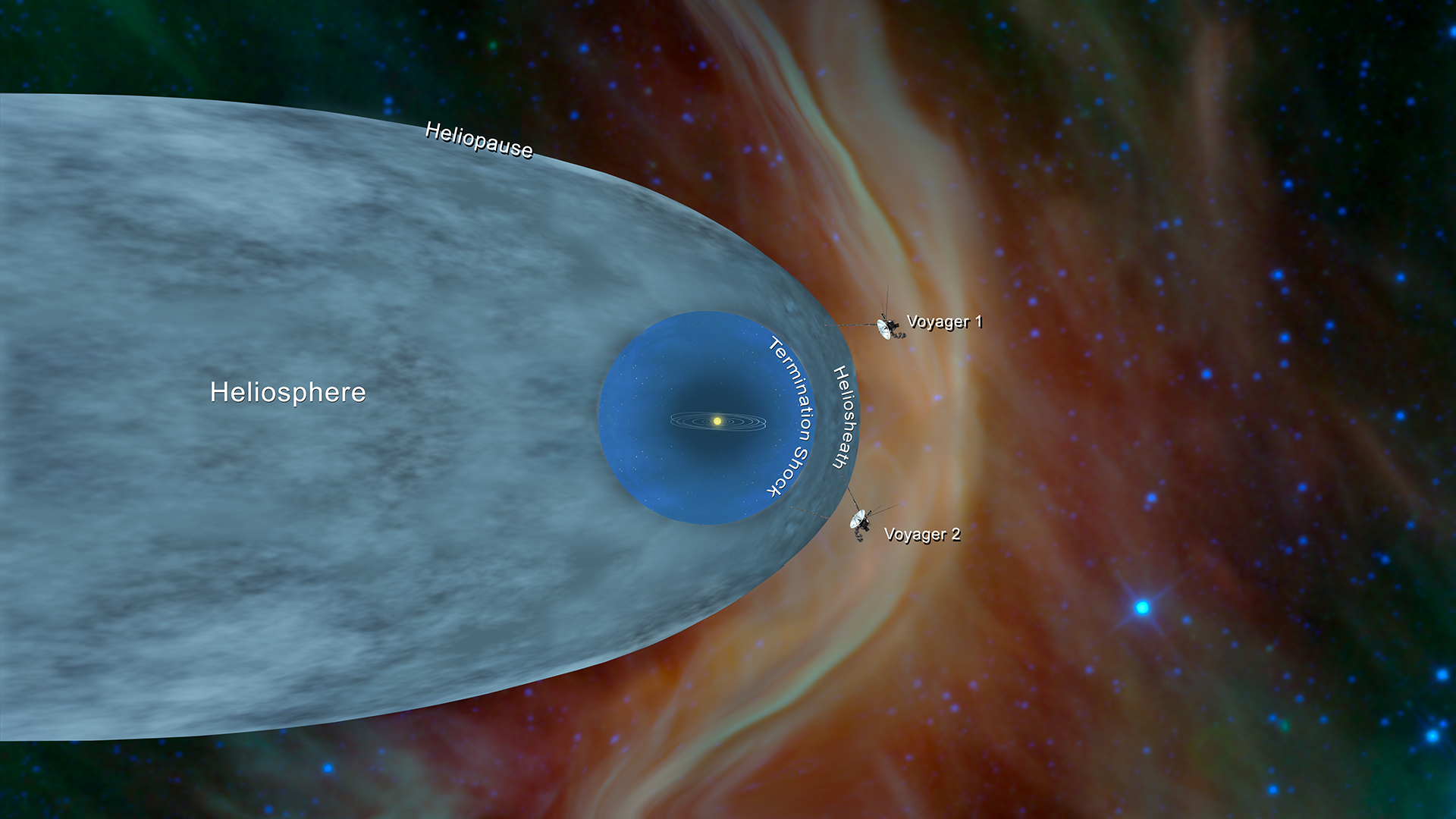NASA is always keen to highlight the space agency’s many successes, and rightly so — those who pay for these expensive projects have a right to know what they’re getting for their money. And so the news was recently sprinkled with stories of the discovery of electron bursts beyond the edge of our solar system, caused by shock waves from coronal mass ejection (CME) from our Sun reflecting and accelerating electrons in interstellar plasmas. It’s a novel mechanism and an exciting discovery that changes a lot of assumptions about what happens out in the lonely space outside of the Sun’s influence.
The recent discovery is impressive in its own right, but it’s even more stunning when you dig into the details of how it was made: by the 43-year-old Voyager spacecraft, each now about 17 light-hours away from Earth, and each carrying an instrument so simple and efficient that they’re still working all after this time — and which very nearly were left out of the mission’s science payload.
Nice Work If You Can Get It

The instrument that made the discovery, the Plasma Wave Subsystem (PWS), can trace its lineage back at least as far as 1958. That’s when Donald Gurnett, an electrical engineering freshman at the University of Iowa, took a job in the lab of Dr. James Van Allen, who had recently discovered the radiation belts surrounding Earth that now bear his name. Van Allen and his team had used a special Geiger counter on Explorer 1, the first satellite flown by the United States, and the results were both exciting and foreboding. It was clear that Earth was surrounded by high-energy charged particles, which was a truly new discovery, but it also meant traveling in space may well be lethal. Moritz recently published a deeper dive into that topic.
More information was needed, so Van Allen set Gurnett to work on instruments for future satellites to explore the environment close to Earth. The team at the University of Iowa came up with innovative digital telemetry systems to replace the simple analog telemetry links used by Explorer 1 and other early satellites. They also devised a series of space radio and plasma wave experiments, in part to explore natural very-low-frequency (VLF) phenomena known as sferics, like whistlers and the “dawn chorus”. The experiments flew on satellite Injun-3 in 1962 and beamed back enough data for Gurnett to build his Ph.D. thesis on.
The lessons learned with these early experiments boosted the nascent field of space radio and plasma wave research and informed the construction of better instruments, which were flown on multiple missions through the 1960s and early 1970s. By then, NASA was deep in the planning stages for the Voyager missions, designed to take advantage of a rare alignment of orbits that would allow a probe to visit the previously unexplored outer reaches of the Solar System with a minimum of maneuvering. Gurnett was among a group of physicists who proposed a plasma wave experiment for Voyager, based mainly on the desire to learn more about the intense radiation belts known to surround Jupiter.
The group’s first proposal for a plasma wave experiment for Voyager was rejected by NASA. It was a bitter disappointment, but the plasma wave community kept after NASA to include some kind of instrument to explore Jupiter’s energetic environment. In 1973, as the clock was ticking to finalize the science payload design for Voyager, Gurnett made a compromise proposal for a plasma wave experiment. The instrument would literally piggyback on an experiment that had already been accepted: the Planetary Radio Astronomy (PRA) experiment. It would share the “rabbit ear” antennas that would be built for the PRA, with a compact spectrum analyzer attached to the enclosure holding the PRA receiver. Mainly on the strength of Gurnett’s proposal, plus the fact that the plasma wave experiment would use only 1.6 Watts of Voyager’s limited power and add only 1.4 kg of mass, NASA accepted the proposal. Soon thereafter, the Plasma Wave Subsystem, which was entirely built at the University of Iowa, was on its way to the outer planets and beyond.
Simple by Design

That the design of the PWS is so simple is probably the key to its success, and has a lot to do with why it’s still running on both Voyagers almost 50 years after launch. The antennas were designed for the PRA experiment but are adequate for measuring the electrical fields of plasma waves (the rejected original proposal included a magnetometer to allow study of the magnetic components of plasma waves). Each element of the antenna is 10 meters long when deployed, set 90° apart. For the PRA experiment, the antennas act as a pair of monopoles, but for PWS they are connected as a balanced dipole.
Storing and deploying 10-meter-long antenna elements in space requires some clever thinking. The PRA/PWS antenna used basically the same technique employed on IMP-6, a satellite in the early 70s that needed antennas up to 45 meters in length. The Storable Tubular Extendable Members antenna, or STEM, was used for both IMP-6 and, in considerably shortened form, on Voyager. It consisted of a sheet of beryllium copper rolled onto a spool, a drive motor, and a forming die. The copper sheet had been formed into a tube before being rolled flat on the spool, and when extended through the die, snapped back into a rigid tube.

The PWS instrument was also simple by design. Each antenna is connected to a preamplifier with a selectable 40 dB attenuator, to prevent the intense Jovian radiation from swamping the electronics. The output of each preamp feeds into a differential amplifier, whose output is proportional to the voltage difference between the two antennas. This signal is passed through a notch filter to remove noise from Voyager’s 2.4-kHz switching power supply before being fed to a 16-channel spectrum analyzer that covers 10 Hz to 56.2 kHz. The 16 filters in the spectrum analyzer generated output signals from 0 to 3 volts, which are sent to the spacecraft’s Flight Data Subsystem for encoding.

The Long Dark
After the long journey past the orbit of Mars and through the asteroid belt, the PWS finally got a chance to prove itself. During the high-speed flybys of each gas giant, calculated to provide a gravitational assist to the next waypoint, the PWS performed a complete scan through all 16 channels every four seconds. The resulting data was stored on the Data Tape Recorder, or DTR, and queued for streaming back to Earth.
Once the Voyager twins had completed their survey of the outer planets in 1989, the Voyager Interstellar Mission began. Planning for the exploration of the lonely black void into which both spacecraft now hurtled had been in the works for quite some time, and it was clear that the PWS would play a major role in whatever discoveries lie ahead. The complex and power-hungry polarimeters, spectrometers, and imaging systems, designed to gather data mainly during planetary encounters, were largely switched off, leaving more power available to the simpler particle detectors and magnetometers, as well as the PWS, to continue exploring the depths of space.

Both Voyagers eventually passed through the boundary where the hot, charged particles streaming out from the Sun, or solar wind, is pushed back by the cooler plasmas of the interstellar medium. The transition through the various layers of rarified plasmas at the edge of the solar system were all noted by PWS data, as was the passage of each spacecraft through the heliopause and into interstellar space, which was marked by a 40-fold increase in plasma density. The PWS was also key to the recent electron-burst discovery.
The Plasma Wave Subsystem, included on the Voyager mission at the last minute, has performed admirably for the last 43 years and has provided us with a detailed picture of what lies at the edge of our solar system. Eventually, and soon now, the plutonium in the Voyager twins’ radioisotope thermal generators will decay to the point where there’s not enough power to keep everything running, but with any luck the Plasma Wave Subsystem will be one of the last instruments to enter its long interstellar sleep.
















Yayy!
Thanks for writing the article.
I see Don Gurnett is still active within the scientific academic community!
https://now.uiowa.edu/2020/12/voyager-spacecraft-detect-new-type-solar-electron-burst
Amen
How many more years of Data will we get before the Voyagers go dark for good?
Reports indicate they will finally stop transmitting any and all data between 2028-2034. Mostly, the time frame is described as, ‘Late 2020’s to early 2030’s.’
I keep getting more and more impressed by the voyager probes for esch article I read. The whole project was a monumental success. And on top of that we are still receiving very useful scientific data. Absolutely incredible. That disc they attached to the probes showing our planets position might not have been the best idea though…
Happy new year!
Amen.
I have always believed the Voyagers are the best scientific achievement of humans, and profoundly primitive “throw this rock as far as you can.”
They’re both now the furthest objects from Earth. Older than the average person.
Astounding.
Best tax dollars I ever spent.
That disc got everybody thinking and talking about the Voyager missons. I suspect that was the main objective all along.
Helped V’Ger find his way home. Talk about a return on an investment.
Lol … Nice
As a species we are not even out of the playpen. Who would want to beat up a bunch of children?
I’d figure that the “die” part that makes the antenna into the tube is not all that dissimilar from that bagel machine we saw earlier in the week.
The problem is the high temperature silicon-germanium thermoelectric couples have dropped in efficiency over time.
At launch:
3 RTG’s in each voyager spacecraft
~4.5kg of plutonium-238 per RTG
(~0.57 watts of thermal power is generated per gram of plutonium-238)
Each RTG generated about 2400 Watts of thermal power
hot junction temperature was 1273 K (1000 °C, 1832 °F)
cold junction temperature of 573 K (300 °C, 572 °F)
Collectively, the RTGs supplied each Voyager spacecraft with 470 watts.
=> each RTG was about ~6.5% efficient at launch
Now:
The half life of plutonium-238 is 87.7 years
After 43 years: 1 – ( 0.5 ^ (43/87.7)) ~= 0.288
There nearly 29% less plutonium-238 than when the RTG’s launched.
So each RTG’s output has dropped down to about ~1700 Watts of thermal power
The total electrical power out, currently drops by about 4 watts per year so it, is down to about ~234 watts
Which would imply that the TEG’s are now about are about 4.6% efficient
Part of that drop is because the the hot junction temperature is now lower, but the biggest loss in efficiency is the TEG’s failing gracefully.
I would imagine that it’s the junction materials diffusing into each other.
Chemistry in action!
And I’m sure that there was also some loss of efficiency due to 47 years cumulative damage from cosmic radiation. And I’m sure some from other elements in the Plutonium-238 which is not 100% pure, “… could not be produced to the specifications, (… snip … which ultimately meant ) loosening of the specifications”
Since I tend to rain on a parade a lot, I will now say that Voyagers are the pinnacle of American science and engineering (with Apollo). They are something that should make USA proud. A real beacon as to what should be pursued, and what improves American image immensely.
I’m still worried the aliens get the wrong impression though, we yeeted out nudes and a mix-tape.
When the aliens see the pictures on the disc I imagine they will be so different from us it will be like the joke “What did the elephant say to the naked man? ‘How do you breathe through that thing?'”
The stuff we’ve sent to Mars is going pretty good as well.
I agree. Excellent job it was, and it still is.
It’s kinda funny how back then, in the cold war era, the mission was perceived as a archivement of humanity as a whole (the golden record containing material of the whole world), whereas space exploration today is all about the glory of the USA (and other nations).. 🙄
PS: Don’t get me wrong, I believe we’re generally all proud of USA/NASA/JPL etc., but for foreigners like me this patriotism feels a bit awkward at times, I guess. 😉
That being said, it’s no offense. You have the right to be proud, of course. Especially in this case. Voyager is one of the few things that represents humanity’s best. 😎
Like Arecibo used to be, it’s also a symbol.
It proves that we can do anything if we really try. That we truely can reach the stars.
And that money is not everything in life, that we can make things last. And that 1970s tech was great! 😁
Maybe Voyager will be a good reminder for this in the upcoming era of commercialization of space travel.
Last, but not least, let’s also remember things wouldn’t have been possible without the pioneers of other times and places around the world and the individuals contributing to the project.
Whoever they may be or may were, wherever they came from, who ever they worked for, wherever they went.
Some of them are still missing in the books of history, likely.
It’s the small interpersonal things in life that often matter, but are rarely valued or written down.
I’m not American either. But I like to praise them when praise is deserved, in ever-present hope they will do more of what’s good for humanity. If that requires flag-waving patriotism, that’s fine. Patriotism is good when it leads to good outcome.
Happy New Year to everyone.
Ah, I see. Makes sense to me.
Let us not forget the two Pioneers who ran off first.
Good point, as we have five probes hurling out of the solar system, if we count the relative newcomer…
17 light years from earth…. Each! Does that mean in 43 years each Voyagers have been travelling at half the speed of light?!? Calling b.s., sorry mates!
Light Hours, not light years.
Its 17 light HOURS not years.
So its only gone 11.4 billion miles in 43 years or 30,265 miles an hour average. Thats around 8.5 miles per sec.
A far cry from 186,300 miles per sec that the speed of light is lol
As the article says, they’re 17 light-hours away, not lightyears.
The craft are 17 light HOURS from Earth.
17 light-hours
That kind of engineering is long gone. Thoughtful, long lasting, humble. Now it’s ‘look at me, I’m brilliant for 2 seconds but it paid.’.
+1
In my humble opinion, the 1970s were truely special in this respect.
Let’s just look at the 555/LM386/741 ICs, Cosmac/RCA CDP1802, the Zilog Z80 or the AO7 satellite..
These were elegant and simple, but not primitve. And they are still around.
Even 1950s tubes like the EF95 (6К8П, 6ES6) stood the test of time.
If we really want to reach the heavens, we need to agree to technology and concepts that last.
So better not constantly rush out highly complex processors and transmission protocols into space,
but rather sit down a moment, think and work out data protocols and radio technology that lasts.
Voyager teached us that missions can last longer than one human life time and that we need
to support radio transmitters and data protocols for a long time.
So better think ahead and design simple, but elegant ways of accomplishing things.
Instead of re-inventing the wheel, “we” could make new Voyagers based upon the old designs.
With todays wisdom and a little bit of refurbishing, the 1970s technology could be made more
power effiecient or even longer lasting. And this involves not replacing the old processor chips by the current gen, no.
Instead, it would be worth a try to make modern replicas of the older proccesors.
These replicas could be “cleaner” more accurately built, with less errata and power consumption.
But at the same time more robust (space hardened) due the use of better materials.
Minitaturization is also a key, but “we” should no overdoo it. If structures are becoming too small,
they will be the victims to radiation. That’s were 1970s technology had its advantages.
It was discrete and massive. Also, redundancy was a key element (three units performing same tasks).
I like your thinking. That approach has another advantage: with simple architecture, it is difficult to slip-in hardware backdoors.
Thanks! :)
I like your comments…we( I guess the Western world) really should be throwing much more research back into radio…we know for example that in China, thousands literally thousands of electrical engineers are working in RF fields…
If society didn’t buy it people wouldn’t make it – bakelite phones happily lasted for a century but I don’t see anyone chopping in their iPhone for one.
Voyager was built that way because that was the available technology and systems of the time, much like ancient buildings / bridges etc. tend to be excessively solid because that was the best way to guarantee it wouldn’t fall down at the time before things like FEA and powerful computers / CAD existed.
New things aren’t awful, they’re incredible – maybe stop sniping at them and look for the positives.
Actually the power source is call the Multihundred-Watt radioisotope thermoelectric generator, “The Helipak”. Invented by the grandfather along with the SNAP-27.
Given the state of the science and engineering when this magnificent project was conceived and implemented the fact that it is still functioning is a massive credit to all involved. I have a real concern that today everything is so complex that its tendency to not work properly or fails is much greater than the likes of Voyager. I would put part of the success of SpaceX down to a much more minimalist solution to the very difficult problem of putting things into space. Everything about Voyager is exceptional from getting it approved, doing the computation to pull off all the slingshots, deciding what kit to use, putting it together and getting it launched in window that was not going to be there for another 160 years holds many lessons for us all. The reality is that today it is too easy to overcomplicate “stuff”, the really clever bit is to keep it simple. To Don and all the other people involved in Voyager you have set us an example we should learn from and not forget. As we fight for the survival of our planet one thing is certain, if we don’t keep it simple we will fail!
Can you just imagine being retired and in your 70s and seeing something you made in your 30s still making headlines for science?
What an amazing project to be a part of. I’m just in awe.
Something similar happened to the makers of the AMSAT OSCAR 7 satellite, I suppose.
The satellite was started in the 1970s, -like the Voyagers-, went silent in the 1980s and came back to life in the 2000s.
https://www.amsat.org/two-way-satellites/ao-7/
There are SIX (most likely) possible endings for the Voyager spacecraft, all of them extremely far into the future. 1) They will speed through interstellar space, never being found, virtually forever. 2) They will be captured by another sun and go into orbit around it, also forever. 3) A rogue comet, asteroid, or other piece of space rock will run into them and destroy them. 4) They will be captured in orbit by another planet or moon far from our Solar System. 5) They will be pulled into the gravity well of a planet and destroyed on entry. 6) They will be discovered by aliens and possibly decoded.
Number six is extremely unlikely, but that’s what the scientists were hoping would happen. And if wonder what happens after THAT…just watch the film ‘Independence Day’. Just kidding on that last bit. :)
or they will just decode it without touching it, that way aliens #2 will not know that aliens #1 decoded it and there will be no need for unfriendly encounters between the two different sub-species.
its like finding a pool of blood next to a broken knife-handle on the beach, you miiight not want to put your fingerprints on it or even be seen reacting as if you noticed it. might send in a drone/satellite/robot to do the sluething.
If aliens ever come this way, I see only a few solutions:
1, The’re friendly and want company, and help us to get nearer to their level.
2. The’re interested in a habitable planet and we get trampled like ants.
3. They come here with friendly intentions but are so annoyed by the mess we make of everything that they trample us like ants anyway.
4. the’re so alien that there is no predicing what they would do.
I do know that movies like indepence day, War of theWolds, etc are so completely unrealistic that the’re not even “entertainment”, like most hollywood stuf, it’s just for dulling the masses.
I love the spacecraft graphic at the top of the article but am compelled to point out that’s a Pioneer 10-11 and not a Voyager.
By the way, back in the day, the pictures of Voyager 2
were re-transmitted via SSTV by amateur radio people, which also held conversations/conferences via SSTV.
This was in a time when SSTV was still mostly in b/w format, similar to Robot-8.
https://www.qsl.net/kd2bd/sstv.html
https://jplarc.ampr.org/calling/1981/sep/sep81.html
I see comments about going back to simpler technology – nonsense! Voyager was the most advanced design using the best tools available at the time. For this old-timer, one of the most impressive achievements was seeing a pair of Falcon heavy boosters return to earth and land upright simultaneously! That took some serious software and planning!
Not exactly going back I’d say – learning from it, improving it.
Over the last years our modern day technology became rather fragile, over-engineered.
Our cars and trains can’t handle a bit of summer heat or snow anymore, for example.
They became sunshine technology, literally.
Or just think of stationary telephones. They used to be powered by the landline.
Or analogue AM/FM radio. It worked entirely independently of the internet and required no microchips. You could build your own easily, even.
It just needs one bigger solar event and our cities become dark (power outage).
In space, were radiation is very strong and never making a pause, things must be very sturdy.
The Voyagers and Pioneers are veterans, but also lasted the longest so far.
That’s why we should appreciate it’s simpler technology.
– It has stood the test of time after all.
(That doesn’t mean we should stop sending out probes with newer technology, of course. It barely means that we should also consider to use Voyager-derived technology in future missions.)
https://futurism.com/nasas-twin-voyager-probes-are-the-most-important-spacecraft-ever-launched
Let’s see if New Horizons will last as long, too. :)
My view is the spectacular success of SpaceX is that they have kept thigs “Simple” compared to NASA. The size of their facility at Cape Canaveral is very small. SpaceX builds a very large proportion of its equipment in house avoiding the bureaucracy of multiple contractors. The technology available for Voyager inherently limited how complex it could be. The engineers had to be super smart to do what they did. A spin off of this has been the very long working life of Voyager. Today it is too easy to use excessive complexity to cover up the fact that you didn’t get the basics right at the beginning. Compare Hubble to James Web and you start to see the risks complexity create.